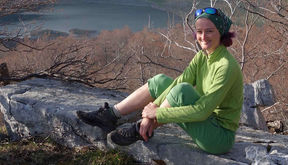Ice researcher will live one year in a Mars-simulation

The experiment is part of a one-year Hawaii Space Exploration Analog and Simulation (HI-SEAS) -mission, which begins on August 28.
Heinicke and the rest of the crew will live in a remote habitat located half-way up the Mauna Loa volcano on the Big Island of Hawaii.
- At this point, I am super excited. It was a relatively spontaneous decision to take part in this mission, as I only sent my application in as late as in mid-May. But having been a finalist for another similar experiment I have had time to get used to the idea of spending one year in isolation, she tells.
At Aalto University Heinicke has worked as a postdoctoral researcher under Professor Jukka Tuhkuri in the Mechanics of Materials group at the Department of Applied Mechanics.
- In terms of research, my work at HI-SEAS will be very different from my research at Aalto. Here, I have worked on sea ice; in Hawaii there may be a slight chance we find some permafrost soil or ice at higher altitudes. Still, after this year is over, returning to Aalto and continuing my work here is definitely an option for me. I really enjoyed my time here and Professor Tuhkuri has been very supportive, she says.
Twelve months as a guinea pig
The study in Hawaii aims at identifying the social, interpersonal and cognitive factors that affects team performance during long-duration space travel, such as missions to Mars. Conditions resemble a Martian research base. The domed habitat has a single window that overlooks vast fields of volcanic rock. Every crew member is required to wear a spacesuit when venturing outside. Communications are delayed by 20 minutes each direction to simulate transmission over interplanetary distances.
During their twelve months the crew will be continuously monitored by surveillance cameras, body movement trackers, electronic surveys and other methods. Besides being the guinea pigs, the crew will also conduct their own research. Christiane Heinicke's projects involve the extraction of water from the ground and sleep.
- We are a team of highly motivated and collaborative people, each competent in their own field. We will have plenty of time and opportunities to learn from each other, she concludes.
The mission is NASA-funded and run by the University of Hawaii.
Christiane Heinicke’s blog about her experience inside the dome is at http://scilogs.de (in German)
Further information:
Detailed biographies and pictures of the new HI-SEAS crew
Contact: Christiane Heinicke, [email protected]
- Published:
- Updated:
Read more news

DeployAI Partners Gather for Heart Beat Meeting in Helsinki
The European DeployAI project's partners gathered for the Heart Beat meeting hosted by Aalto University Executive Education in Helsinki.
Get to know us: Associate Professor Maria Sammalkorpi
Sammalkorpi received her doctorate from Helsinki University of Technology 2004. After her defence, she has worked as a researcher at the Universities of Princeton, Yale and Aalto.
Aalto computer scientists in ICML 2024
Computer scientists in ICML 2024